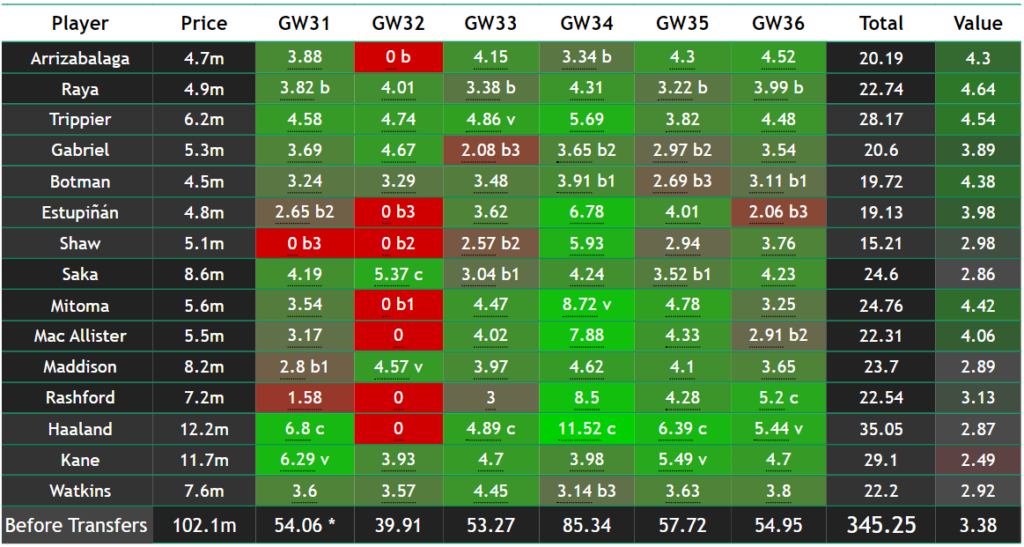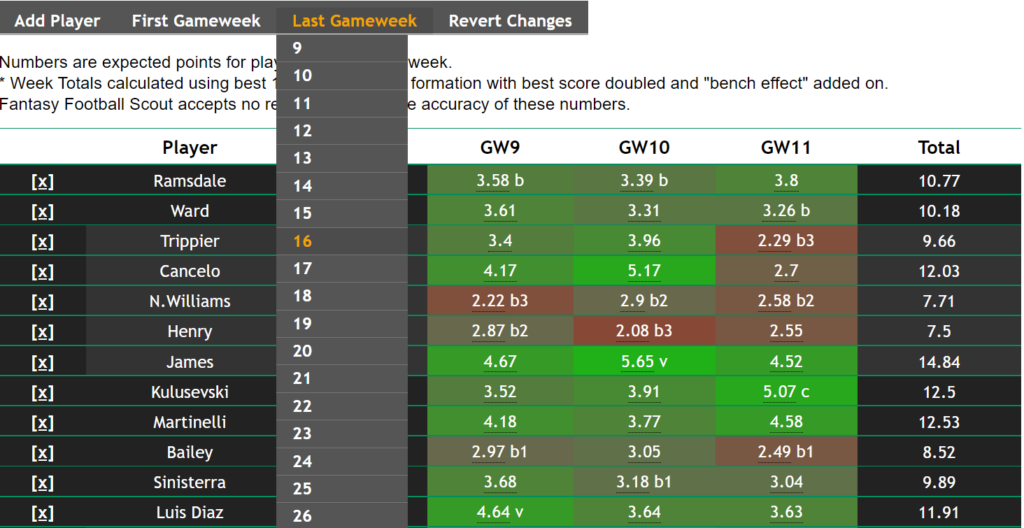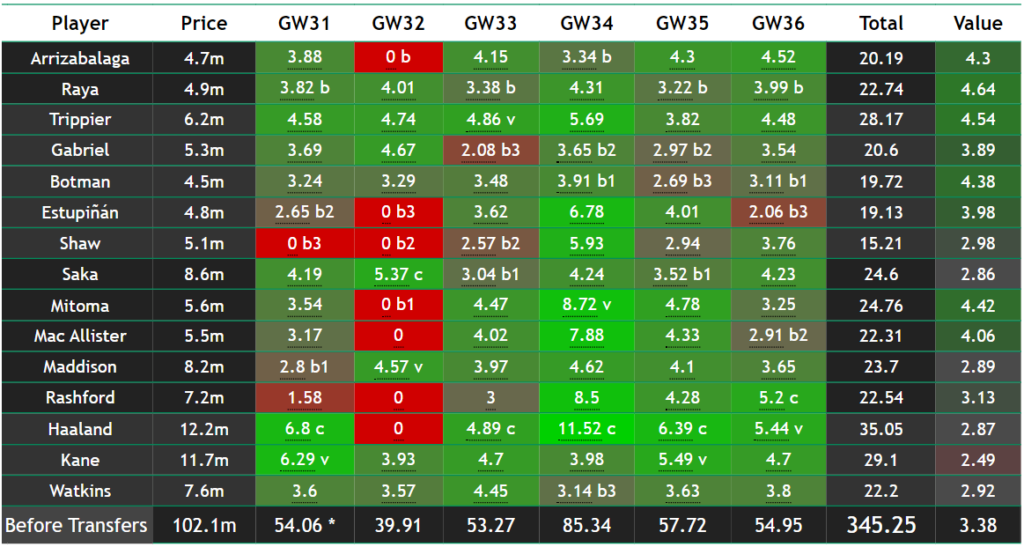Looking to see how many points your Fantasy Premier League (FPL) team will score over the final six Gameweeks? Stuck between two transfer targets? Wondering who could offer good value?
While you can never be sure of what chaos FPL will bring, our Rate My Team (RMT) tool is here to help! RMT’s points projections for Gameweeks 33-38 are provisionally available now.
These figures will be fine-tuned closer to the deadline after the pre-match press conferences have taken place and we learn about who is carrying a knock and who is ruled out.
Premium Members of Fantasy Football Scout can see the players heading the points projections for both this upcoming Gameweek and the next five beyond it in the images below but you can get the full picture here.
You can even get a breakdown of the points, from attacking returns to clean sheets, here.
Our Rate My Team tool, meanwhile, can give you an approximation of how many FPL points your own team will score over a series of Gameweeks.
GAMEWEEK 33: FPL POINTS PROJECTIONS
HELP AND FREQUENTLY ASKED QUESTIONS
WHAT IS RATE MY TEAM?
Rate my Team (RMT) is a tool designed to give you an approximation of how many FPL points your team will score over a series of Gameweeks. This takes into account captaincy, vice-captains and automatic substitution points.
WHAT ARE PROJECTIONS?
Projections come in two forms – Season Projections and Six-Gameweek Projections (SGP).
Season projections show algorithm-generated predictions for every FPL player. This includes goals, assists, clean sheets, minutes played, bonus points, yellow cards and, most importantly, FPL points.
SGP shows algorithm-generated predictions for every player’s FPL points in each of the next six Gameweeks, calculating their points per million value over this period. These numbers are the same numbers as the ones used in RMT.
HOW ARE THE VALUES FOR RATE MY TEAM AND PROJECTIONS CALCULATED?
The values are generated by an algorithm that uses both current and historical data. There is also constant human monitoring so that the model can respond quickly to news, injuries or tactical changes that otherwise the algorithm may underestimate.
We do this to generate the best values with as little bias as possible.
HOW DO I LOAD MY TEAM INTO RMT?
To load your team into RMT, you need to type in your FPL ID.
If you can’t find your FPL ID, instructions on how to find it are on the Rate My Team page.
WHAT DO XM AND ADJP MEAN?
Placing the cursor over a player’s predicted FPL points in a Gameweek will show an xM score and an adjP score.
xM stands for expected minutes – It’s the number of minutes the algorithm is predicting a player to have. Note that this isn’t an exact Gameweek specific prediction but rather an average number of minutes. Therefore, while a player might be expected to play 90 minutes, their xM will be lower since there’s a chance they might miss the game or get substituted.
adjP is the expected points – how many points the algorithm predicts a player will score in the week if they were to play 90 minutes.
Both of these values combine to generate a final score.

WHY DOES RMT SAY TO START A PLAYER WITH A LOWER PREDICTED SCORE THAN A SECOND PLAYER?
Usually, this occurs because the algorithm predicts that a player (usually a goalkeeper) will either play the full game or won’t feature at all.
Player A – High adjP, very low xM – Low RMT score
Player B – Medium adjP, very high xM – Medium RMT score
Whilst Player A is unlikely to play, the most common scenarios is that they’ll either be given 90 minutes or none at all. Therefore, RMT thinks it’s worth starting him to make use of the high adjP if he plays, otherwise the safer option of Player B will autosub in.
Therefore it suggests picking Player A over B, despite the former appearing to score lower on RMT.
WHY DOES RMT SAY TO CAPTAIN A PLAYER WITH A LOWER PREDICTED SCORE THAN A SECOND PLAYER?
We know, as Fantasy managers, that we have a vice-captain who will sub in if our captain doesn’t play.
So sometimes we might captain a player who may not feature knowing that our vice will assume the armband if that happens. But we choose to captain him because if he does play, he is likely to get the most points.
The same applies when selecting our starting XI and bench; we might start a player who is unlikely to feature but – if he does – is expected to do well. Safe in the knowledge that he will be replaced by a sub should he miss out.
The RMT understands this. In fact, it produces two sets of numbers:
- The ones we display on site, which include the possibility that the player’s minutes could be 0
- The ones we display on the rollover in the ‘adjP’
The adjP score is the one described above and should/can be used for selecting captain and starting XI. It basically says if a player features in the match, how many points is he likely to get?
That player could still be a sub and get a yellow card, that possibility is included, the difference is it excludes zero minutes of playing time.
So essentially you would use the first set of numbers for transfers and the ‘adjP’ for captain and bench.
CAN I ORDER BY SCORES FOR ONE GAMEWEEK?
From the list of all players in RMT or projections, just click on the Gameweek header to sort the players by that Gameweek’s predicted score.
HOW DO I CHANGE THE GAMEWEEKS I VIEW RMT OVER?

At the top of the Rate My Team page, whilst you have your team loaded, you can select “First Gameweek” and “Last Gameweek”. By default, the first Gameweek will be the next Gameweek and the last Gameweek will be in six Gameweeks’ time, but these can be manually altered to suit your research.
CAN I SEE A FULL LIST FOR ALL PLAYERS IN RMT?
You can find the complete list here. It can also be found by clicking the “Players” option in the sub-menu under “Rate My Team” on the main Premium Members Area menu.
WHEN DO UPDATES HAPPEN?
While there’s no fixed update timetable, it is pretty much continuous.
Monday tends to have a big update after the weekend’s events. Thursday and Friday will have updates in the evenings following any news that emerges from pre-match press conferences.

